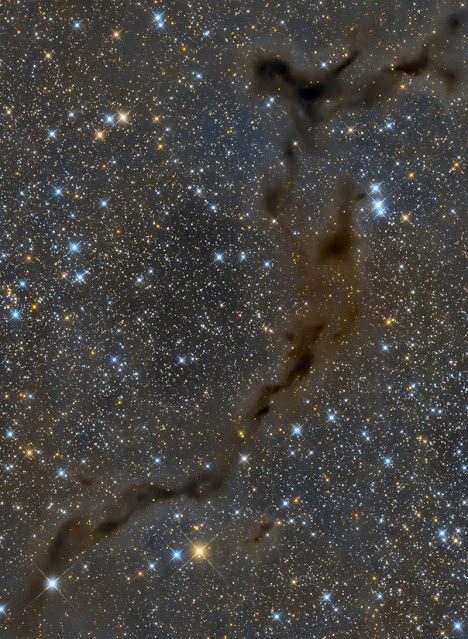Once again....WOW
The Dark Seahorse in Cepheus : Light-years across, this suggestive shape known as the Seahorse Nebula appears in silhouette against a rich, luminous background of stars. Seen toward the royal northern constellation of Cepheus, the dusty, obscuring clouds are part of a Milky Way molecular cloud some 1,200 light-years distant. It is also listed as Barnard 150 (B150), one of 182 dark markings of the sky cataloged in the early 20th century by astronomer E. E. Barnard. Packs of low mass stars are forming within, but their collapsing cores are only visible at long infrared wavelengths. Still, the colorful stars of Cepheus add to this pretty, galactic skyscape. via NASA
Wow....
NGC 6995: The Bat Nebula : Do you see the bat? It haunts
this cosmic close-up of the eastern Veil Nebula. The Veil Nebula itself is a
large supernova remnant, the expanding debris cloud from the death explosion of
a massive star. While the Veil is roughly circular in shape and covers nearly 3
degrees on the sky toward the constellation of the Swan (Cygnus), NGC 6995,
known informally as the Bat Nebula, spans only ½ degree, about the apparent
size of the Moon. That translates to 12 light-years at the Veil’s estimated
distance, a reassuring 1,400 light-years from planet Earth. In the composite of
image data recorded through narrow band filters, emission from hydrogen atoms
in the remnant is shown in red with strong emission from oxygen atoms shown in
hues of blue. Of course, in the western part of the Veil lies another seasonal
apparition: the Witch’s Broom Nebula. via NASA
Ghost Head Nebula taken with the Hubble Space Telescope.
Similar to the icon of a fictional ghost, NGC 2080 is actually a star forming
region in the Large Magellanic Cloud, a satellite galaxy of our own Milky Way
Galaxy. The Ghost Head Nebula (NGC 2080) spans about 50 light-years and is
shown in representative colors. via NASA
Cartwheel Galaxy PGC 2248
500 Million light years away in the aptly named constellation of
Sculptor, but a JWST breaks no sweat.
The IR composite image adds so much detail about the dynamics of the galaxy, the outer ring thought to be a shockwave emanating from centre as a smaller galaxy (not in this image) interacted as they passed by over 400 million years ago. The inner ring is also a similar event, and represents a dense area of star formation , both rings are expanding outwards. What I love about JWST images, is the abundance of galaxies in the background, Webb really picks up galaxies stretching back billions of light years.
Crab : This pretty field of view spans over 2 degrees or 4 full moons on the sky, filled with stars toward the constellation Taurus, the Bull. Above and right of center in the frame you can spot the faint fuzzy reddish appearance of Messier 1 (M1), also known as the Crab Nebula. M1 is the first object in 18th century comet hunter Charles Messier’s famous catalog of things which are definitely not comets. Made from image data captured this October 11, there is a comet in the picture though. Below center and left lies the faint greenish coma and dusty tail of periodic comet 67P Churyumov-Gerasimenko, also known as Rosetta’s comet. In the 21st century, it became the final resting place of robots from planet Earth. Rosetta’s comet is now returning to the inner solar system, sweeping toward its next perihelion or closest approach to the Sun, on November 2. Too faint to be seen by eye alone, the comet’s next perigee or closest approach to Earth will be November 12. via NASAMirach s Ghost : As far as ghosts go, Mirach’s Ghost isn’t really that scary. Mirach’s Ghost is just a faint, fuzzy galaxy, well known to astronomers, that happens to be seen nearly along the line-of-sight to Mirach, a bright star. Centered in this star field, Mirach is also called Beta Andromedae. About 200 light-years distant, Mirach is a red giant star, cooler than the Sun but much larger and so intrinsically much brighter than our parent star. In most telescopic views, glare and diffraction spikes tend to hide things that lie near Mirach and make the faint, fuzzy galaxy look like a ghostly internal reflection of the almost overwhelming starlight. Still, appearing in this sharp image just above and to the right of Mirach, Mirach’s Ghost is cataloged as galaxy NGC 404 and is estimated to be some 10 million light-years away. via NASA
*** OPPORTUNITIES FOR PLAYWRIGHTS ***
Druid New Writing Script Submissions 2022
The company accepts plays in the English language. For the purposes of clarity:
Druid accepts translations of original plays into English which meet our
criteria.
For the open submission process, a reading panel assists the Artistic Director
in assessing your play and ensures that a range of perspectives are brought to
bear on each submission.
***
Athena Project’s new Read & Rant program seeks to combine the original
form’s sharing of theatrical work with the wider public with the new play
development aspects of Plays In Progress while also fostering collaboration
between playwrights and dramaturgs. We are initiating these changes to Read
& Rant with the goal to create digital opportunities for early and mid-career
playwrights, uplift women* writers and dramaturgs overall, and highlight
underrepresentation for women* in these positions.
***
Brave New World Repertory Theatre is seeking new play submissions for Brave New
Works: Ditmas Park 2022 Reading Series. This season, we are especially looking
to feature LGBTQIA+ stories.
Three original, full-length plays (under 120 pages) will be selected and given
minimally staged readings between January 10th – March 30th, 2022 (if we are
unable to have in-person readings due to COVID19, they will be done virtually).
*** FOR MORE INFORMATION about these and other opportunities see the web site
at https://www.nycplaywrights.org
***












